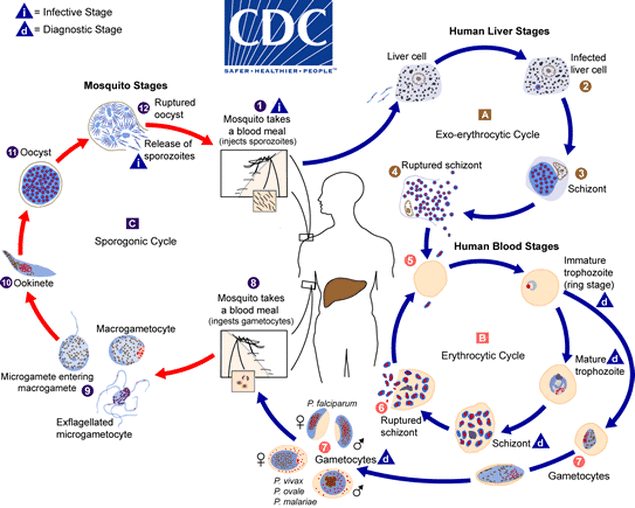Malaria - PLASMODIUM INTRODUCTION
Malaria is a potentially-deadly disease caused by some very complex species of single-celled parasites from the genus Plasmodium. These shape-shifting eukaryotic organisms are extremely complex. They have far more genes than do viruses or bacteria. They contain intracellular organelles, have nuclei and at various times in their lifecycle reproduce sexually or asexually. Throughout their lifecycles, Plasmodia live in a variety of locations including the mosquito midgut, mosquito salivary glands and in human liver cells (hepatocytes) and red blood cells (RBCs). Along the way, they traverse skin and blood vessels in a continuous effort to maintain their lifecycle.
According to the World Health Organization, ~3.2 billion people (50% of the world's population) are at risk for malaria and in 2021, there were ~247 million cases and ~619,000 deaths. While improved and increasing prevention and control measures have reduced malaria mortality dramatically, even better interventions (particularly a highly effective vaccine) are needed to achieve the ultimate goal of malaria elimination worldwide.
The U.S. Center for Disease Control and Prevention has a very nice site detailing the basics of malaria infection and the Plasmodium lifecycle. The lifecycle from the CDC is show below (link here).
According to the World Health Organization, ~3.2 billion people (50% of the world's population) are at risk for malaria and in 2021, there were ~247 million cases and ~619,000 deaths. While improved and increasing prevention and control measures have reduced malaria mortality dramatically, even better interventions (particularly a highly effective vaccine) are needed to achieve the ultimate goal of malaria elimination worldwide.
The U.S. Center for Disease Control and Prevention has a very nice site detailing the basics of malaria infection and the Plasmodium lifecycle. The lifecycle from the CDC is show below (link here).
CDC DPDX website: http://www.cdc.gov/dpdx/Malaria/
Here's Sean dressed as the entire Plasmodium lifecycle for Halloween (a long time ago it seems!)
Here's Sean dressed as the entire Plasmodium lifecycle for Halloween (a long time ago it seems!)

